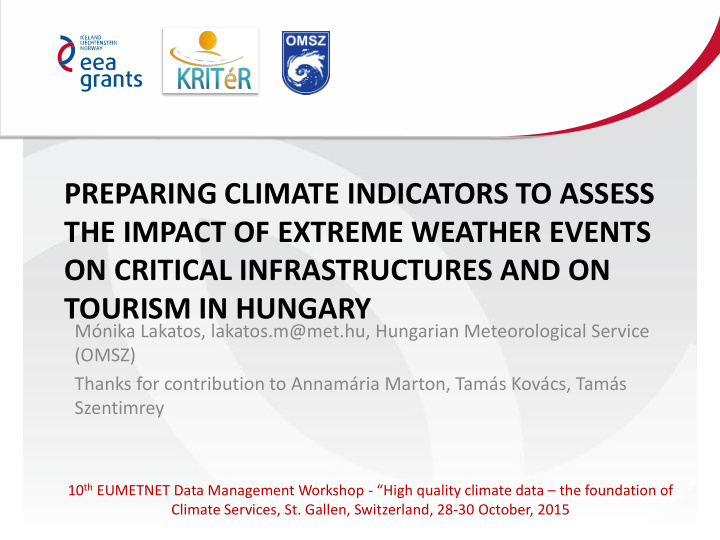



PREPARING CLIMATE INDICATORS TO ASSESS THE IMPACT OF EXTREME WEATHER EVENTS ON CRITICAL INFRASTRUCTURES AND ON TOURISM IN HUNGARY Mónika Lakatos, lakatos.m@met.hu, Hungarian Meteorological Service (OMSZ) Thanks for contribution to Annamária Marton, Tamás Kovács, Tamás Szentimrey 10 th EUMETNET Data Management Workshop - “High quality climate data – the foundation of Climate Services, St. Gallen, Switzerland, 28-30 October, 2015
Motivation • 2009-2014 Programme of EEA: Programme for Adaptation to climate change in Hungary - National Adaptation Geo-information System (NAGIS) in Hungary (see poster 43) • NAGIS: Homogenized gridded dataset from meteorological observations for 1961 – 2010 and climate projections for 2021 – 2050 and 2071 – 2100 • Extension of the NAGIS for further sectors: KRITéR- CRIGiS project: Vulnerability/Impact Studies with a focus on Tourism and Critical Infrastructures • For targeted and sustainable adaptation high quality climate information is needed
Objectives • The KRITéR- CRIGiS project is focusing (i) heatwave-induced excess mortality, impacts of (ii) extreme weather events on road accidents, and (iii) of climatic conditions on tourism • Identification of climate indicators to assess the impact of (ii) extreme weather events on road accidents in winter (iii) of climatic conditions on tourism • Results for observational dataset
National Adaptation Geo- information System (NAGIS) Observations: 1961-2010 CarpatClimHu daily grids Aladin spatial resolution: 0.1° Climate RegCM several basic meteorological variables and climate indicators CarpatCli mHu Regional Climate model simulations: 2021 – 2050 : „short - term” planning and 2071 – 2100: long- NAGIS term strategy
CarpatClim project ~ 10 km grid, daily, 1961- 2010, 13 ECVs, 37 climate indicators, publically available http://www.carpatclim-eu.org Variable and time period based selection Searchable Metadata Catalog Homogenized and griddded by MASH and MISH
CarpatClim - CarpatClimHu 68 climate stations Variable Description units Ta 2 m mean daily air º C temperature Tmin Minimum air temperature º C Tmax Maximum air temperature º C p Accumulated total mm precipitation DD 10 m wind direction, Degrees 0-360 VV 10 m horizontal wind speed m/s Sunshine Sunshine duration hours cc Cloud cover tenths Rglobal Global radiation J/cm 2 RH Relative humidity % pvapour Surface vapour pressure hPa pair Surface air pressure hPa Snow depth Snow depth (ZAMG model) cm
IDENTIFICATION OF CLIMATE INDICATORS TO ASSESS THE IMPACT OF SEVERE WEATHER ON PUBLIC ROAD ACCIDENTS IN WINTER
Recommend
More recommend